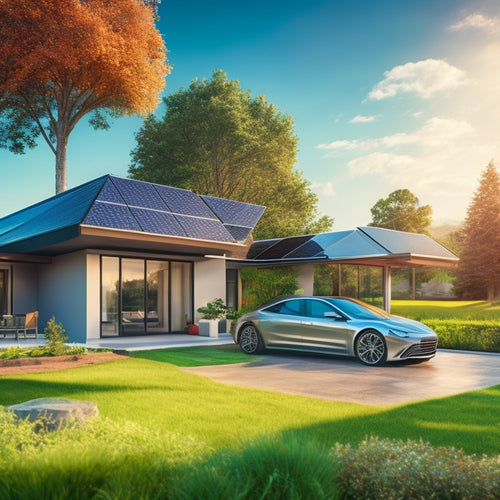
Boost Your Ride: 7 Tips for Solar Car Charging
Share
You're taking the first step towards a more sustainable and eco-friendly way of owning an electric vehicle by harnessing the power of solar energy to charge your ride. To get started, choose a high-efficiency solar panel that fits your budget and energy needs. Select a compatible charger that meets your EV's requirements, and optimize your charging schedule to maximize energy production. Consider energy storage options, monitor your energy levels, and park in the right spot to boost energy absorption. By following these tips, you'll be well on your way to a greener and more efficient ride - and there's even more to discover as you continue on this journey.
Key Takeaways
• Choose a high-efficiency solar panel with adequate wattage and consider budget for installation costs to ensure optimal energy generation.
• Select a compatible charger that matches your EV's requirements, considering maximum power output, voltage, and amperage ratings for safe energy transfer.
• Optimize your charging schedule by planning sessions based on daily commute and energy requirements to avoid overcharging or undercharging.
• Park your vehicle in direct sunlight to maximize energy absorption, and avoid shaded areas or parking garages that reduce energy absorption.
• Regularly clean and maintain your solar charger to ensure optimal energy absorption, extend its lifespan, and prevent damage and costly repairs.
Choose the Right Solar Panel
When selecting a solar panel for your solar car charging system, consider the wattage and efficiency ratings to make sure you're generating enough power to meet your vehicle's charging needs. You don't want to be stuck with a panel that's as useful as a chocolate teapot!
Panel efficiency is key here. Look for a panel with high efficiency ratings (around 20% or higher) to maximize energy production. This will make certain you're getting the most bang for your buck.
However, high-efficiency panels often come with a higher price tag. Installation costs can add up quickly, so it's crucial to balance your energy needs with your budget. Be prepared to shell out a bit more cash upfront for a high-quality panel, but remember, you'll be saving money (and the planet) in the long run!
Select a Compatible Charger
Selecting a charger that's compatible with your electric vehicle (EV) and solar panel is crucial to guarantee smooth energy transfer and prevent any damage to your car's battery or the charging system.
You don't want to risk frying your EV's onboard computer or blowing a fuse in your solar panel. So, what makes a charger compatible?
First, check the charger specifications to make sure they match your EV's requirements. Look for the maximum power output, voltage, and amperage ratings.
Next, verify the charger certifications, such as UL (Underwriters Laboratories) or ETL (Intertek), which assure the charger meets safety standards. Don't settle for a charger that's not certified – it's not worth the risk.
Optimize Your Charging Schedule
As you optimize your charging schedule, you'll want to take into account the times when your solar panels are generating the most energy, which are typically during peak charging hours.
You'll also need to think about charging your car when you need it, rather than sticking to a rigid schedule.
Peak Charging Hours
By optimizing your charging schedule to avoid peak charging hours, you can reduce your electricity costs and alleviate strain on the grid.
You're not alone in trying to juice up your ride, and the grid can get overwhelmed during rush hour (around 5-7 pm).
To sidestep this, consider charging your solar-powered vehicle during off-peak hours, like late at night or early in the morning.
Charge When Needed
You can optimize your charging schedule by charging your solar car when necessary, taking into account your daily commute and energy requirements. This approach guarantees you're not overcharging or undercharging your battery, which can affect its lifespan.
Consider your daily driving habits and plan your charging sessions accordingly. If you have a short commute, you might only need to charge your car every other day. On the other hand, if you're planning a road trip, you'll want to top up your battery as much as possible before hitting the road.
Be mindful of time constraints, too. If you're short on time, charge your car during the most efficient hours – usually when the sun is shining brightly. This way, you'll get the most energy out of your solar panels.
Smart Scheduling Tools
Your solar car's charging schedule can be streamlined with smart scheduling tools that analyze your energy needs and optimize charging sessions to maximize solar energy output. These tools help you make the most of your solar energy by identifying the best times to charge your car. By prioritizing your energy needs, you can guarantee that your car is fully charged when you need it most.
Here's a breakdown of how smart scheduling tools can benefit you:
| Feature | Benefit |
|---|---|
| Time Blocks | Schedule charging sessions during off-peak hours to reduce energy costs |
| Priority Alerts | Receive notifications when your car's battery is fully charged or when charging is interrupted |
| Energy Forecasting | Plan your charging sessions based on predicted solar energy output |
With smart scheduling tools, you can optimize your charging schedule to maximize your solar energy output. By taking advantage of off-peak hours and prioritizing your energy needs, you can save money and reduce your carbon footprint. Stay ahead of the game with smart scheduling tools that help you make the most of your solar car's potential.
Consider Energy Storage Options
Electric vehicle owners who want to harness the power of the sun to charge their cars must carefully consider energy storage options to guarantee a steady and reliable supply of electricity. You don't want to be stuck with a dead battery when the sun goes down, do you? That's why it's crucial to explore energy storage options that fit your needs.
One option is battery swaps, which allow you to replace your depleted battery with a fully charged one. This method is particularly useful for long road trips or when you don't have access to a charging station.
Another option is to connect to the grid, which enables you to tap into the electrical grid when the sun isn't shining. This way, you can charge your car even when the sun is hiding behind the clouds.
Monitor Your Energy Levels
When it comes to monitoring your energy levels, you'll want to identify your energy consumption patterns to optimize your solar car charging experience.
You'll need to track your energy usage to understand how much energy your car requires and when. By doing so, you'll be able to pinpoint areas where you can adjust your energy consumption to maximize your solar-powered driving range.
Energy Consumption Patterns
Monitoring your energy levels involves tracking the amount of power your solar car consumes at different times of the day and under various driving conditions. Think of it as conducting an energy audit on your daily habits. By monitoring your energy consumption patterns, you'll identify areas where you can optimize your energy usage and maximize your solar car's performance.
Here's a breakdown of your energy consumption patterns:
| Time of Day | Energy Consumption (kWh) | Driving Conditions |
|---|---|---|
| Morning Commute | 2.5 | Heavy traffic, air conditioning on |
| Lunch Break | 1.2 | Idle, engine off, accessories on |
| Evening Cruise | 3.8 | Highway driving, music blasting |
| Overnight Charging | 5.0 | Vehicle charging, no driving |
Track Energy Usage
By analyzing your energy consumption patterns, you'll need to track energy usage in real-time to optimize your solar car's performance and identify opportunities for improvement.
Think of it as keeping an eye on your energy budget – you wouldn't overspend on gas, would you?
To track energy usage, you'll need to monitor your meter readings regularly. This will give you a clear picture of your energy consumption habits, helping you identify areas where you can cut back and make adjustments to maximize your solar car's performance.
Park in the Right Spot Matters
Parking your electric vehicle in a spot with direct sunlight can greatly enhance the amount of energy your solar car charger absorbs. You might be thinking, 'Why does it matter where I park?' Well, let me tell you - it makes a substantial difference! Direct sunlight can increase energy absorption by up to 20%.
On the other hand, parking in shaded areas or parking garages can considerably reduce the energy your charger can harness. Imagine trying to get a sunburn on a cloudy day - it's just not happening!
When searching for the perfect parking spot, aim for areas with minimal obstruction, like open parking lots or streets with minimal tree cover. Avoid parking under awnings or canopies, as they can block sunlight. If you're stuck parking in a shaded area, try to angle your vehicle to maximize exposure to indirect sunlight.
Maintain Your Solar Charger
Regular cleaning of your solar car charger's photovoltaic cells guarantees optimal energy absorption, as dust and debris can reduce its efficiency by up to 10%. You wouldn't want all that sunshine going to waste, right?
To keep your charger in top shape, follow these simple maintenance tips:
-
Dust off regularly: Use a soft-bristled brush or a microfiber cloth to wipe away dust and debris that can accumulate on the photovoltaic cells.
-
Avoid water exposure: Keep your charger away from puddles, pools, and even heavy rain. Water and electricity don't mix, and you don't want to risk damaging your charger.
-
Inspect for damage: Regularly inspect your charger for signs of damage, such as cracks or broken cells. If you notice any damage, have it repaired or replaced ASAP.
- Clean the frame: Don't forget to clean the charger's frame and mounting system to guarantee a secure and stable installation.
Frequently Asked Questions
Can I Use Any Solar Panel With My Car's Charging System?
You can't just slap any solar panel on your car's charging system, sorry! Verify panel compatibility by checking voltage, current, and connector types, and consider system integration for a seamless, safe, and efficient charge.
How Long Does It Take to Fully Charge My Car's Battery?
"You're wondering how long it takes to fully charge your ride's battery, right? Well, it depends on the battery capacity and charge time - typically 4-8 hours for a 50Ah battery, but it varies, so check your manual for specifics, dude!"
Are Solar Chargers Compatible With All Electric Vehicle Models?
You're wondering if solar chargers play nice with all electric vehicle models? Check your vehicle's manufacturer specifications, as compatibility varies - some solar chargers are designed for specific models, while others are more universal, so do your research!
Can I Charge My Car's Battery on a Cloudy Day?
You can still charge your car's battery on a cloudy day, but energy harvesting will be slower due to reduced sunlight. Don't worry, though - most solar chargers are designed to perform decently even with cloudy performance, so you'll still get some juice!
Are Solar Chargers Safe to Use in Extreme Weather Conditions?
You're wondering if solar chargers can handle extreme weather conditions? Rest assured, they're built with weather resistance and climate durability in mind, so go ahead and charge on, rain or shine!
Related Posts
-

What Solar Panels Work Best With EVS Online?
When shopping for solar panels online to power your electric vehicle, look for high-efficiency models that can withst...
-

Step-by-Step Guide to Converting Your Vehicle to EV
You'll begin by evaluating your vehicle's conversion potential, analyzing its weight, aerodynamics, and powertrain co...
-

What Role Do Unicycles Play in Urban Transport?
As you navigate through congested city streets, unicycles emerge as a viable solution, slashing carbon emissions by u...


